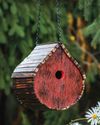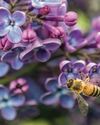Experts share why leaves change and predict when to hit the road for the colorful show.

Athy Mathews loves to watch the sugar maples turn yellow, orange and red at Great Smoky Mountains National Park near her home. “Sometimes you’ll see all three colors on the same leaf,” she says. An associate professor of biology at Western Carolina University, Kathy has spent 10 years studying and predicting peak viewing time for fall colors. She still marvels at the magic of fall, when green leaves transform into brilliant eye-catching copper shades.
This phenomenon occurs when trees stop producing chlorophyll, a green substance in leaves that interacts with sunlight throughout spring and summer to make food for trees to grow. Changing weather conditions in fall tell the trees it’s time to store sugars in the roots for next year’s growth. As the cool temperatures approach, daylight hours shorten and the chlorophyll breaks down, revealing the bright hidden hues.
“It is more efficient for the tree to do this than to maintain its leaves year-round,” Kathy says. Some trees, including maples, even create a new pigment—a deep rich red.
This story is from the October/November 2018 edition of Birds & Bloom.
Start your 7-day Magzter GOLD free trial to access thousands of curated premium stories, and 8,500+ magazines and newspapers.
Already a subscriber ? Sign In
This story is from the October/November 2018 edition of Birds & Bloom.
Start your 7-day Magzter GOLD free trial to access thousands of curated premium stories, and 8,500+ magazines and newspapers.
Already a subscriber? Sign In

Clever Cowbirds
Learn more about these birds that are infamous for letting others raise their young

Ask the Experts
Pros offer spring plant care tips and tough IDs

Rustic diy Birdhouse
Whether you're hardcore handy or an everyonce-in-a-while crafty person, you probably have a small pile of scrap wood handy. Grab your tools and turn your extra materials into any house wren's dream nest box.

THE LATEST IN Lilacs
Learn about updated varieties of this timeless classic and how to take care of them

Meet the ORIOLES
GET TO KNOW eight TYPES SEEN THROUGHOUT THE U.S. AND WHAT MAKES EACH ONE STAND OUT

CBD FOR YOUR PAIN
Everyone feels the hurt as you age, but CBD can help you deal with it

Welcome, New Blooms
Update your yard with 2024's freshest florals

Western Blues
Beckon these regional bluebirds to your yard with nest boxes and mealworms

Incredible Eggs
Fun facts about these tough yet fragile wonders

Life Well Lived
Surprising facts about bird life spans